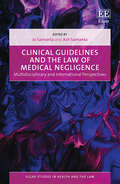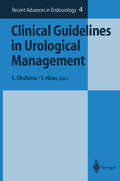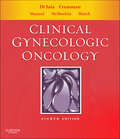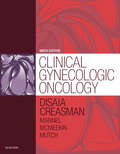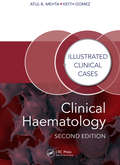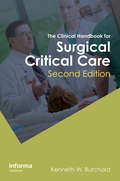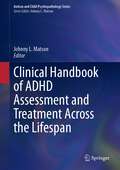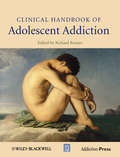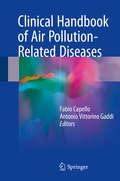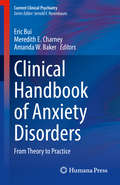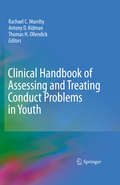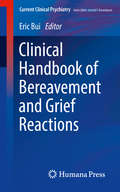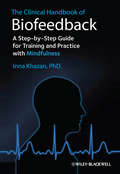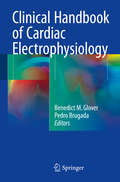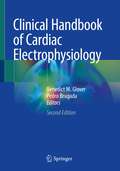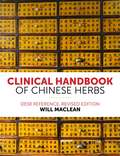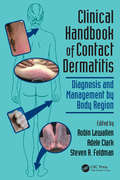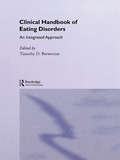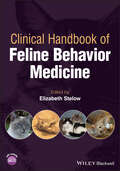- Table View
- List View
Clinical Guidelines and the Law of Medical Negligence: Multidisciplinary and International Perspectives (Elgar Studies in Health and the Law)
This book critically considers the dynamic relationship between clinical guidelines and medical negligence litigation, arguing that a balance must be struck between blinkered reliance on guidelines and casual disregard. It explores connections between academic law and professional practice, bringing together an array of perspectives which reveal that although guidelines may not be dispositive, they nonetheless play an important role in medical negligence law.The chapters provide compelling insights from academics, lawyers, barristers, doctors and healthcare professionals into the use of guidelines in determining the legal standard for breach of duty, thereby contributing to a holistic understanding of guideline usage in this area of law. Sociological considerations along with empirical findings are used to underpin these concepts. While focusing on the UK, contributors draw upon international law including that from the United States, South Africa, the Netherlands and other countries. Based on this analysis the conclusion offers a theoretical framework for practical application illustrated by a case-based discourse.This book makes a significant contribution to the knowledge base in the subject area. It is an essential read for legal academics and lawyers working in medical and health law, as well as for doctors and other healthcare professionals. It will be a key reference point for medical regulators, health organisation policymakers and clinical governance teams.
Clinical Guidelines in Urological Management (Recent Advances in Endourology #4)
by YoshihikoHirao ShinichiOhshimaThe twenty-first century will be the era of the market economy, a century char acterized by the penetration of market forces into every social field, even into government activities, education, and medical care. Guidelines for the provision of clinical care have been developed in recent years chiefly in American health-care services, which are the most thoroughly exposed to the market economy. The problem of escalating medical costs in the United States led the government and consumer groups to introduce clinical practice guidelines. Guidelines were introduced to control medical costs and quality. Initially, guidelines were developed mainly on the consumer side, but professionals, too, soon recognized the importance of clinical practice guidelines. The involvement of diverse groups in the development of guidelines has inten sified the need to create and improve scientific methods for drawing up those guidelines. Owing to the development of systematic and structured abstraction methods, evidence-based guidelines have been proposed. Principally, guidelines are a sum mary of published treatments created by statistical analysis of clinical outcomes.
Clinical Gynecologic Oncology E-Book
by Philip J. DiSaia William T. CreasmanClinical Gynecologic Oncology, by Drs. Di Saia and Creasman, is the leading medical reference book geared toward helping you improve gynecologic cancer outcomes. You’ll see how to take advantage of the latest advances in early detection and improved treatment options for gynecologic cancers, especially uterine and cervical cancers, equipping you with the skills you need to provide effective and compassionate care for your patients.Easily identify and absorb key information with outlines beginning each chapter. Choose the best management plan for each patient using algorithms throughout the book. Stay at the forefront of your field thanks to new chapters on Genetic Counseling and Clinical Management of Inherited Disease; Molecular Genetics; and Minimally Invasive Surgery, plus sweeping updates covering all the latest advances. Find everything you need to face your daily challenges with appendices covering staging, screening, nutritional therapy, toxicity criteria, blood component therapy, and radiation therapy. Locate answers fast with a chapter organization based on cancer type and size.
Clinical Gynecologic Oncology E-Book: Expert Consult - Online And Print
by Philip J. DiSaia William T. Creasman Robert S Mannel D. Scott McMeekin David G MutchThe most readable, most comprehensive book in its field, Clinical Gynecologic Oncology, 9th Edition is the leading reference for diagnosis and treatment of gynecologic cancers – a must-have reference for improving outcomes and providing effective care. A "who’s who" list of contributing authors, under the editorial direction of Drs. Philip DiSaia and William Creasman, provides expert guidance on clinical presentations and management, now fully up to date with a brand-new design for faster, easier reference.Contains useful appendices covering staging, screening, nutritional therapy, toxicity criteria, blood component therapy, and radiation therapy.Covers hot topics such as multi-panel genetic testing, target therapies, sentinel node concept in endometrial cancer and vulvar cancer, and robotic surgery. Updates include new quick-reference features such as key point boxes with bulleted lists, highlighted key text, enhanced chapter outlines, and a brand-new design throughout. Includes up-to-date references and algorithms, making this text a comprehensive resource for clinical practice, personal study, and exam review. Helps you take advantage of the latest advances in early detection and improved treatment options for gynecologic cancers, especially uterine and cervical cancers.
Clinical Haematology: Illustrated Clinical Cases (Illustrated Clinical Cases)
by Atul Bhanu Mehta Keith GomezThis fully illustrated text is an essential guide for trainees in Haematology and Medicine studying for higher examinations, as well as for professionals wishing to expand their knowledge or revalidate. The book contains over 100 illustrated cases covering the whole field of malignant and non-malignant haematology, including coagulation problems and infectious diseases. Each case contains a set of questions written by two Royal College examiners, with answers on the reverse page. Readers can make differential diagnoses and devise treatment plans and prognoses, before turning the page to read the experts’ detailed answers. The cases are presented in random order – just as they would be in real life – and are of varying lengths and degrees of difficulty, accompanied by hundreds of colour photomicrographs, photographs, and x-rays. This new edition is revised and updated, with new cases, images, and tables.
Clinical Haematology: Illustrated Clinical Cases (Illustrated Clinical Cases)
by Atul Bhanu Mehta Keith GomezThis fully illustrated text is an essential guide for trainees in Haematology and Medicine studying for higher examinations, as well as for professionals wishing to expand their knowledge or revalidate. The book contains over 100 illustrated cases covering the whole field of malignant and non-malignant haematology, including coagulation problems and infectious diseases. Each case contains a set of questions written by two Royal College examiners, with answers on the reverse page. Readers can make differential diagnoses and devise treatment plans and prognoses, before turning the page to read the experts’ detailed answers. The cases are presented in random order – just as they would be in real life – and are of varying lengths and degrees of difficulty, accompanied by hundreds of colour photomicrographs, photographs, and x-rays. This new edition is revised and updated, with new cases, images, and tables.
The Clinical Handbook for Surgical Critical Care
by K. W. BurchardThe Clinical Handbook for Surgical Critical Care, Second Edition covers all aspects of acute and emergency care for the critically ill or injured patient who may be in the ICU and/or CCU. This new edition is separated into chapters by organ systems, and takes a look at the critical disease states associated with these organs. All chapters follow th
Clinical Handbook of ADHD Assessment and Treatment Across the Lifespan (Autism and Child Psychopathology Series)
by Johnny L. MatsonThe handbook examines the latest research and clinical advancements in assessing and treating ADHD (attention deficit hyperactivity disorder) across the lifespan. It synthesizes the most current research data and trends combined with best-practice interventions to form a comprehensive, state-of-the-art resource. The handbook identifies the most relevant, effective treatments for individuals with ADHD. Key areas of coverage include: Core symptoms of ADHD in minority children. Lifestyles for children with ADHD. Digital interventions for children and adolescents with ADHD. Telemedicine to manage ADHD across the lifespan. Healthcare use and costs for adults with ADHD. The Clinical Handbook of ADHD Assessment and Treatment Across the Lifespan is an essential reference for researchers, professors, and graduate students as well as clinicians and other professionals across such interrelated disciplines as clinical child, school, and developmental psychology, child and adolescent psychiatry, social work, rehabilitation medicine/therapy, pediatrics, and special education.
Clinical Handbook of Adolescent Addiction
by Richard RosnerSince 1960, the burden of adolescent illness has shifted from the traditional causes of disease to the more behavior-related problems, such as drinking, smoking and drug abuse (nearly half of American adolescents have used an illicit drug sometime during their life). Instilling in adolescents the knowledge, skills, and values that foster physical and mental health will require substantial changes in the way health professionals work and the way they connect with families, schools, and community organizations. At the same time, the major textbooks on addiction medicine and addiction psychiatry devote relatively little attention to the special problems of diagnosing and treating adolescent addicts. Similarly, the major textbooks on general and child and adolescent psychiatry direct relatively little attention to the issues surrounding adolescent addiction. The Clinical Handbook of Adolescent Addiction is one response to the challenge of meeting the mental health needs and behavior-related problems of addicted teenagers. The work has been edited as an independent project by members of the American Society for Adolescent Psychiatry, the oldest professional organization of psychiatrists devoted solely to the mental health care and treatment of teenagers in the USA. The forensic psychiatry perspective permeates the entire book. It will help to produce health providers with a deep and sensitive understanding of the developmental needs and behavior-related problems of adolescents. The Clinical Handbook of Adolescent Addiction is a practical tool for all those who help adolescents: practitioners of family medicine, general psychiatrists, child/adolescent psychiatrists, adolescent psychiatrists, addiction psychiatrists, non-psychiatric physicians specializing in addiction medicine, forensic psychiatrists, psychologists, clinical social workers, mental health administrators, Court/Probation/ Parole/Correctional health workers. The book is organized in a user-friendly format so that readers can easily locate the chapters that provide the information that is required. In some instances, topics of special importance deliberately have been addressed in more than one chapter, to illuminate the topics from a variety of vantage points. One aim of the editors is to move the topic from being a specialist area to a generalist one by providing tools for generalist to use.
Clinical Handbook of Adolescent Addiction
by Richard RosnerSince 1960, the burden of adolescent illness has shifted from the traditional causes of disease to the more behavior-related problems, such as drinking, smoking and drug abuse (nearly half of American adolescents have used an illicit drug sometime during their life). Instilling in adolescents the knowledge, skills, and values that foster physical and mental health will require substantial changes in the way health professionals work and the way they connect with families, schools, and community organizations. At the same time, the major textbooks on addiction medicine and addiction psychiatry devote relatively little attention to the special problems of diagnosing and treating adolescent addicts. Similarly, the major textbooks on general and child and adolescent psychiatry direct relatively little attention to the issues surrounding adolescent addiction. The Clinical Handbook of Adolescent Addiction is one response to the challenge of meeting the mental health needs and behavior-related problems of addicted teenagers. The work has been edited as an independent project by members of the American Society for Adolescent Psychiatry, the oldest professional organization of psychiatrists devoted solely to the mental health care and treatment of teenagers in the USA. The forensic psychiatry perspective permeates the entire book. It will help to produce health providers with a deep and sensitive understanding of the developmental needs and behavior-related problems of adolescents. The Clinical Handbook of Adolescent Addiction is a practical tool for all those who help adolescents: practitioners of family medicine, general psychiatrists, child/adolescent psychiatrists, adolescent psychiatrists, addiction psychiatrists, non-psychiatric physicians specializing in addiction medicine, forensic psychiatrists, psychologists, clinical social workers, mental health administrators, Court/Probation/ Parole/Correctional health workers. The book is organized in a user-friendly format so that readers can easily locate the chapters that provide the information that is required. In some instances, topics of special importance deliberately have been addressed in more than one chapter, to illuminate the topics from a variety of vantage points. One aim of the editors is to move the topic from being a specialist area to a generalist one by providing tools for generalist to use.
Clinical Handbook of Air Pollution-Related Diseases
by Fabio Capello Antonio Vittorino GaddiThis book examines in detail the clinical implications of those diseases that either are primarily triggered by air pollution or represent direct consequences of air pollutants. The aim is to provide medical practitioners with practical solutions to issues in diagnosis and treatment while simultaneously furnishing other interested parties with crucial information on the field. The book introduces the concept that air pollution-related diseases constitute a new class of pathologies. A wide range of conditions mainly attributable to air pollution are discussed, covering different body systems and pollution impacts in subsets of the population. In addition to presenting state of the art overviews of clinical aspects, the book carefully examines the implications of current knowledge for social and public health strategies aimed at disease prevention and prophylaxis. The Clinical Handbook of Air Pollution-Related Diseases will greatly assist doctors and healthcare workers when dealing with the consequences of air pollution in their everyday practice and will provide researchers, industry, and policymakers with valuable facts and insights.
Clinical Handbook of Anxiety Disorders: From Theory to Practice (Current Clinical Psychiatry)
by Eric Bui Meredith E. Charney Amanda W. BakerThis book is designed to present a state-of the-art approach to the assessment and management of anxiety disorders. This text introduces and reviews the theoretical background underlying anxiety and stress psychopathology, addresses the issues faced by clinicians who assess individuals presenting with anxiety in different contexts, and reviews the management of and varied treatment approaches for individuals with anxiety disorders. Written by experts in the field, the book includes the most common demographics and challenges for physicians treating anxiety, including disorders in children, aging patients, personality disorders, drug and non-drug treatment options, as well as anxiety in comorbid patients. Clinical Handbook of Anxiety Disorders is a valuable resource for psychiatrists, psychologists, students, counselors, psychiatric nurses, social workers, and all medical professionals working with patients struggling with anxiety and stress-related conditions.
Clinical Handbook of Assessing and Treating Conduct Problems in Youth
by Rachael C. Murrihy, Antony D. Kidman and Thomas H. OllendickConduct problems, particularly oppositional defiant disorder (ODD) and conduct disorder (CD), are the most common mental health problems affecting children and adolescents. The consequences to individuals, families, and schools may be severe and long-lasting. To ameliorate negative outcomes and ensure the most effective treatment for aggressive and antisocial youth, early diagnosis and evidence-based interventions are essential.Clinical Handbook of Assessing and Treating Conduct Problems in Youth provides readers with both a solid grounding in theory and a comprehensive examination of the evidence-based assessment strategies and therapeutic practices that can be used to treat a highly diverse population with a wide range of conduct problems. It provides professional readers with an array of evidence-based interventions, both universal and targeted, that can be implemented to improve behavioral and social outcomes in children and adolescents.This expertly written resource:Lays the foundation for understanding conduct problems in youth, including epidemiology, etiology, and biological, familial, and contextual risk factors.Details the assessment process, with in-depth attention to tools, strategies, and differential diagnosis.Reviews nine major treatment protocols, including Parent-Child Interaction Therapy (PCIT), multisystemic therapy (MST) for adolescents, school-based group approaches, residential treatment, and pharmacotherapy.Critiques the current generation of prevention programs for at-risk youth.Explores salient issues in working effectively with minority youth.Offers methods for evaluating intervention programs, starting with cost analysis.This volume serves as a one-stop reference for all professionals who seek a solid grounding in theory as well as those who need access to evidence-based assessment and therapies for conduct problems. It is a must-have volume for anyone working with at-risk children, including clinical child, school, and developmental psychologists; forensic psychologists; social workers; school counselors and allied professionals; and medical and psychiatric practitioners.
Clinical Handbook of Bereavement and Grief Reactions (Current Clinical Psychiatry)
by Eric BuiThis book is designed to present a state-of the-art approach to the assessment and management of bereavement-related psychopathology. Written by experts in the fi eld, it addresses the recent shift in the fi eld calling for greater recognition of bereavement-related psychopathology, as evidenced by the removal of bereavement from the exclusion criteria for major depressive disorder and the provisional inclusion of a bereavement disorder as a condition requiring further study in the DSM-5. Th is text introduces and reviews the theoretical background underlying bereavement-related psychopathology, addresses the issues faced by clinicians who assess bereaved individuals in diff erent contexts, and reviews the management of and varied treatment approaches for individuals with grief reactions.Clinical Handbook of Bereavement and Grief Reactions is a valuable resource for psychiatrists, psychologists, students, counselors, psychiatric nurses, social workers, and all medical professionals working with patients struggling with bereavement and grief reactions.
The Clinical Handbook of Biofeedback: A Step-by-Step Guide for Training and Practice with Mindfulness
by Inna Z. KhazanA practical guide to the clinical use of biofeedback, integrating powerful mindfulness techniques. A definitive desk reference for the use of peripheral biofeedback techniques in psychotherapeutic settings, backed by a wealth of clinical research Introduces mindfulness and acceptance techniques and shows how these methods can be incorporated into biofeedback practice Step-by-step instructions provide everything a clinician needs to integrate biofeedback and mindfulness including protocols, exemplar logs for tracking symptoms, and sample scripts for mindfulness exercises Includes scientifically robust treatment protocols for a range of common problems including headaches, hypertension and chronic pain
The Clinical Handbook of Biofeedback: A Step-by-Step Guide for Training and Practice with Mindfulness
by Inna Z. KhazanA practical guide to the clinical use of biofeedback, integrating powerful mindfulness techniques. A definitive desk reference for the use of peripheral biofeedback techniques in psychotherapeutic settings, backed by a wealth of clinical research Introduces mindfulness and acceptance techniques and shows how these methods can be incorporated into biofeedback practice Step-by-step instructions provide everything a clinician needs to integrate biofeedback and mindfulness including protocols, exemplar logs for tracking symptoms, and sample scripts for mindfulness exercises Includes scientifically robust treatment protocols for a range of common problems including headaches, hypertension and chronic pain
Clinical Handbook of Cardiac Electrophysiology
by Benedict M. Glover Pedro BrugadaThis book provides a detailed summary of all aspects of cardiac electrophysiology, presented in an easy to use handbook. For each arrhythmia the aetiology, classification, clinical presentation, mechanism, and electrophysiology is set up (including precise set up and ablation parameters) and trouble-shooting are presented and demonstrated using interesting images, fluoroscopy images, ECG’s and electrograms.The overall aim of this book is to provide a logical and practical approach to cardiac arrhythmia management. It acts as a useful resource and, importantly, helps to promote this sub-specialty. This book is aimed at cardiac electrophysiologist’s, fellows, cardiologists, physicians, family practitioners, cardiology trainees, students, allied professionals and nurses. Given its succinct summary of electrophysiology is a useful reference guide for the electrophysiology laboratory. It is aimed at an international audience and provides an important guide for those studying for all heart rhythm exams.
Clinical Handbook of Cardiac Electrophysiology
by Benedict M. Glover Pedro BrugadaThis extensively revised second edition provides a practically applicable guide for the management of cardiac arrhythmia. This subject has continued to expand rapidly, and it is therefore critical to understand the basic principles of arrhythmia mechanisms in order to assist with diagnosis and the selection of an appropriate treatment strategy. Comprehensively revised chapters cover a variety of aspects of cardiac electrophysiology in an easy-to-digest case-based format. For each case of arrhythmia, relevant illustrations, fluoroscopy images, ECGs and endocavity electrograms are used to describe the etiology, classification, clinical presentation, mechanisms, electrophysiology set up and relevant trouble-shooting procedures. New topics covered include the application of new antiarrhythmic drugs in tandem with ablation, techniques for the ablation of atrial fibrillation and electrophysiological assessments available for identifying instances of atrial tachycardia. Clinical Handbook of Cardiac Electrophysiology presents a comprehensive overview of cardiac electrophysiology, making it a valuable reference for practicing and trainee cardiac electrophysiologists, cardiologists, family practitioners, allied professionals and nurses.
Clinical Handbook of Chinese Herbs: Desk Reference, Revised Edition
by Will MacleanThis revised edition of Maclean's classic Clinical Handbook of Chinese Herbs is an extensive and detailed guide to the medicinal properties of traditional Chinese herbs, and how they should be prescribed in today's medical practice. The handbook employs comparative charts to help clinicians to select the optimal medicinals for their patients. Each table outlines the characteristics of a group of herbs, including extensive indications with relative strengths of action and function, the domain, flavour, nature, and dosage guidelines. The book also caters for special circumstances in health that may alter a patient's requirements, with appendices giving need-to-know instructions for a number of specific cases. Easy-to-use and comprehensive, the handbook will facilitate efficient comparative reference, as well as detailing the fine points of discrimination.
Clinical Handbook of Chinese Herbs: Desk Reference, Revised Edition (PDF)
by Will MacleanThis revised edition of Maclean's classic Clinical Handbook of Chinese Herbs is an extensive and detailed guide to the medicinal properties of traditional Chinese herbs, and how they should be prescribed in today's medical practice. The handbook employs comparative charts to help clinicians to select the optimal medicinals for their patients. Each table outlines the characteristics of a group of herbs, including extensive indications with relative strengths of action and function, the domain, flavour, nature, and dosage guidelines. The book also caters for special circumstances in health that may alter a patient's requirements, with appendices giving need-to-know instructions for a number of specific cases. Easy-to-use and comprehensive, the handbook will facilitate efficient comparative reference, as well as detailing the fine points of discrimination.
Clinical Handbook of Contact Dermatitis: Diagnosis and Management by Body Region
by Robin Lewallen Adele Clark Steven R. FeldmanThe Clinical Handbook of Contact Dermatitis: Diagnosis and Management by Body Region uses a succinct approach to help clinicians manage this multifaceted condition. Organized by body region, the handbook presents the most common allergens and irritants for a given location. It discusses products containing common allergens and irritants such as top
Clinical Handbook of Contact Dermatitis: Diagnosis and Management by Body Region
by Robin Lewallen Adele Clark Steven R. FeldmanThe Clinical Handbook of Contact Dermatitis: Diagnosis and Management by Body Region uses a succinct approach to help clinicians manage this multifaceted condition. Organized by body region, the handbook presents the most common allergens and irritants for a given location. It discusses products containing common allergens and irritants such as top
Clinical Handbook of Eating Disorders: An Integrated Approach
by Timothy D. BrewertonEmphasizing that accurate diagnosis is the foundation for effective treatment regimens, this reference reviews the most current research on the assessment, epidemiology, etiology, risk factors, neurodevelopment, course of illness, and various empirically-based evaluation and treatment approaches relating to eating disorders-studying disordered eati
Clinical Handbook of Eating Disorders: An Integrated Approach (Medical Psychiatry Ser. #Vol. 26)
by Timothy D. BrewertonEmphasizing that accurate diagnosis is the foundation for effective treatment regimens, this reference reviews the most current research on the assessment, epidemiology, etiology, risk factors, neurodevelopment, course of illness, and various empirically-based evaluation and treatment approaches relating to eating disorders-studying disordered eati
Clinical Handbook of Feline Behavior Medicine
by Elizabeth StelowClinical Handbook of Feline Behavior Medicine Comprehensive resource offering practical and accessible guidance on managing behavior problems in cats Clinical Handbook of Feline Behavior Medicine provides a complete, easy-to-use reference to practical information on identifying, diagnosing, and treating behavior problems in cats. Designed to offer streamlined access to concrete guidance for managing feline behavior, the book offers diagnostic plans organized by clinical sign. Normal behavior is thoroughly described, to provide a better understanding of the abnormal, with the heart of the book devoted to advice for identifying, diagnosing, and treating specific behavior problems. The book describes the diagnostic process and covers treatment options for each problem. A companion website offers client education handouts to enhance compliance and video clips depicting presenting complaints. Sample topics covered in Clinical Handbook of Feline Behavior Medicine include: Normal feline social behavior, covering body language and other social communication, feline social structure, interactions with humans and other species, and social/behavioral development in the kitten Preventing behavior problems, covering feeding, litter box availability and care, scratching options, toys, and grooming Elimination problems, including the differentiation between urine marking and toileting, deducing the underlying causes, and elements of effects treatment plans Senior cats, covering feline cognitive decline, increased vocalization, sleep-wake cycle disturbances, disorientation, litterbox problems, and repetitive behaviors With its specific topical focus of behavior in felines, Clinical Handbook of Feline Behavior Medicine is a targeted and highly useful resource for any veterinarian seeing feline patients, assisting through all stages of treatment with easily accessible and understandable information.
